From Amido and Purushottama’s holiday break in 2002: visit to the Golden Pagoda, Inle Lake and Bagan in what was formerly called Burma
After a few months teaching English as a foreign language in Hong Kong, for our first break, the Christmas holidays, we flew to Yangon with a stopover in Bangkok, Thailand. We almost missed that second leg of the flight, because we had a very late night out in Bangkok with my brother Sean, who coincidentally happened to be there. Fortunately, we had arranged to share a taxi to the airport with him. (He was more accustomed to late nights than we were!) He came and banged on our door until we answered. Forever grateful to him!
Tourism and the political situation in Myanmar are closely intertwined. For years, only very few people were allowed to visit the country. The military government tightly controlled entry. Things started to loosen up in the 1990s when those in power found themselves in desperate need of foreign currency, and reasoned that tourism offered an opportunity to bring some in.
Yangon
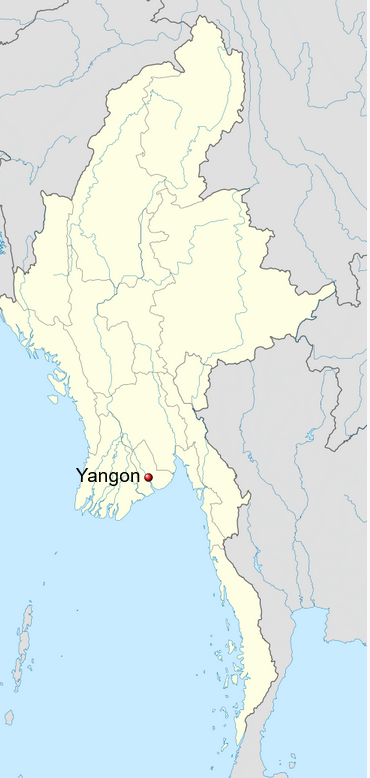 Yangon (formerly called Rangoon) 1 sits on the eastern edge of the Irrawaddy River delta and is the largest city in Myanmar, with a population estimated at six million. 2 It was the capital of Myanmar until 2005/6, when the military government moved the capital to Naypidaw, a purpose-built city in the north of the country. Yangon, however, remains the primary commercial, economic, and cultural center. The name Yangon means, ironically, ‘end of strife’.
Yangon (formerly called Rangoon) 1 sits on the eastern edge of the Irrawaddy River delta and is the largest city in Myanmar, with a population estimated at six million. 2 It was the capital of Myanmar until 2005/6, when the military government moved the capital to Naypidaw, a purpose-built city in the north of the country. Yangon, however, remains the primary commercial, economic, and cultural center. The name Yangon means, ironically, ‘end of strife’.
On arriving in Yangon, we made our way to the White House, a guesthouse we had picked out from our Lonely Planet guidebook. For many years Lonely Planet was the only publisher covering Myanmar; all others refused to feature it, not wanting to cooperate in any way with the repressive military regime.
The first morning we woke up to the sound of Buddhist chants – reminding me that I was in a Buddhist country… – and I felt a sense of expansion in the embrace of those sacred sounds.
The jewel of the entire trip was going to be the Shwedagon Pagoda, also called the Golden Pagoda. Shwe means gold, dagon was the name the Mon people called this ancient city before it was renamed Yangon in the 18th century CE. And pagoda is another word for stupa, which is a domed hemispherical structure containing relics of the Buddha, or Buddhist nuns and monks. 3
The Shwedagon Pagoda is reputed to be the oldest Buddhist temple in the world and, according to legend, was built whilst Buddha was still in the body. The current construction, however, is dated by scholars to between the 6th and 10th century CE. It’s the most sacred, and the most famous, Buddhist pagoda in Myanmar. It fortunately survived the earthquake of 28th March 2025.
The gilded pagoda (officially named Shwedagon Zedi Daw: The Great Golden Mountain Stupa) is said to contain eight strands of Gautama the Buddha’s hair, as well as relics from three Buddhas who lived prior to Gautama the Buddha.
This was the first time I became aware that relics from the Buddha existed at all and that they had been placed in various temples in different countries. I treasure that information as I treasure my small box from Osho.
The Shwedagon Pagoda is a fabulous place to wander around: a large marble platform set on a hill – and therefore visible from all parts of the city – with shrines to the four Buddhas occupying each corner of the complex. This is a functioning religious center. Monks and nuns meditate and chant, creating an atmosphere of reverence undisturbed by the ebb and flow of lay people walking around. The stupa is a living, integrated part of life.
Though the pagoda is clad in an impressive quantity of gold and precious stones, that to me did not seem the most important of its attributes. We spent the whole afternoon there, and on into the early evening… We found it difficult to leave.
Left: Yangon is not a clean city, nor a quiet one! (The Shwedagon Pagoda can be seen at the end of the street.)
Right: The cutest and most endearing of salespeople.
People do what they can to get by.
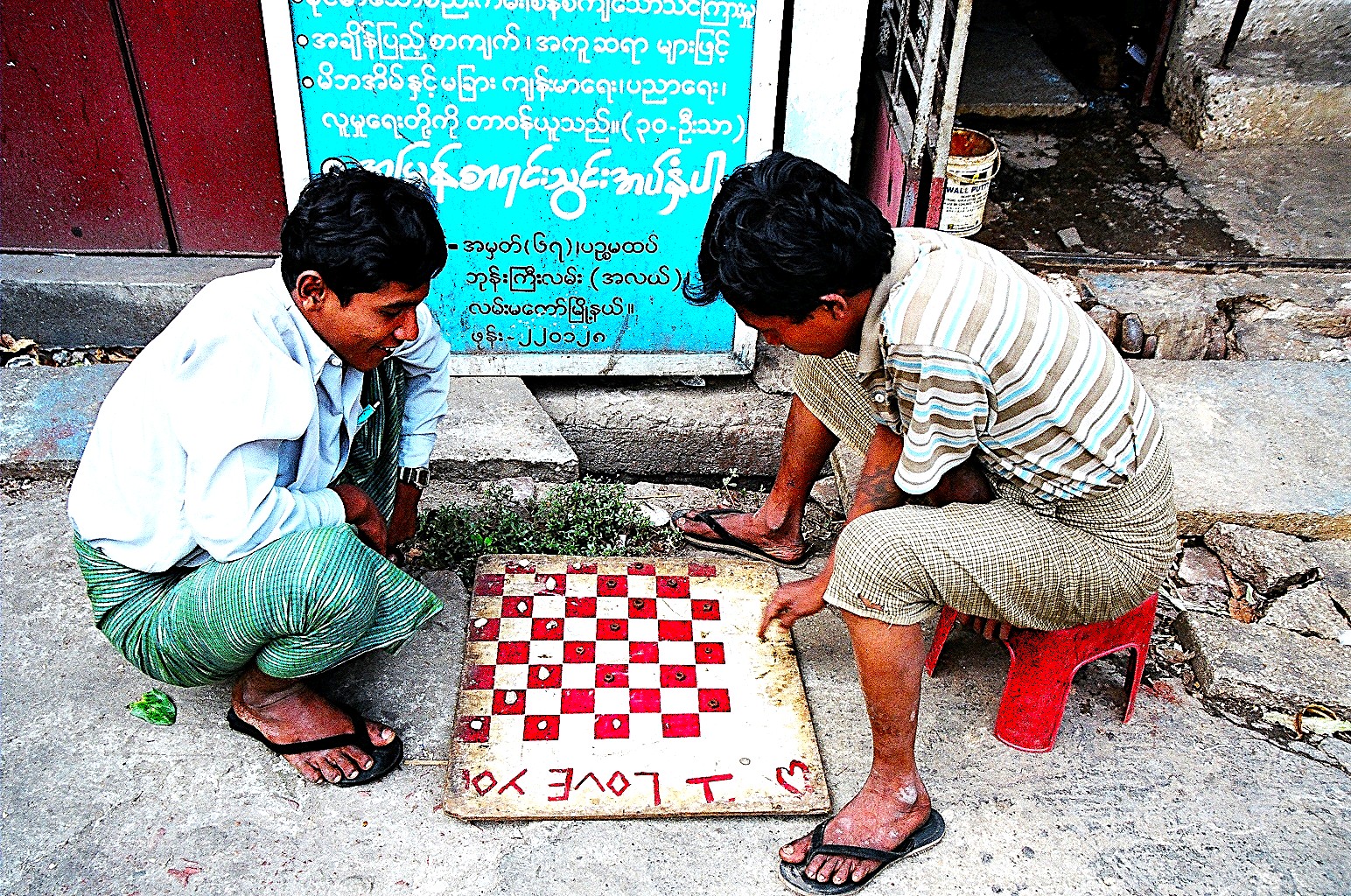
But it is not all work.
The owner of the guesthouse was a lovely Indian man – so truly kind to the assorted bunch of oddball foreigners who had made their way to Myanmar. He prepared an amazing feast for everyone to celebrate Christmas and supplied us daily with an ample breakfast. What stays in my memory the most is the unique contraption we used to toast our bread – on the table – it was a metal bowl standing on small legs with coals glowing in it, and with a latticed metal cover. We would place the bread on the curved lattice cover and voilà, in moments, it was time to flip it over and toast the other side! There were also eggs and butter and jam. Food is so important when you travel! I still feel a kind of glow in my heart when I think of him.
In Myanmar at the time you couldn’t withdraw money from an ATM machine. There was a banking crisis, which was slowly festering – from 2002 into early 2003 – and many banks collapsed. It appears the issue was an excess of debt to assets, and as a result of this crisis, it was not until 2012 that Myanmar again had ATMs. Which meant that one had to travel with cash; a fact some unfortunate travelers were not aware of. Money could then be changed on the black market. We met an American who had somehow managed to remain in Myanmar for an extended period. To show us how, he opened his overcoat and displayed a vest arrangement with individual transparent pockets for his dollars!
At our guesthouse we also met a young man from the Czech Republic who had been working as a gardener in the UK. He was penniless, having arrived without cash on the assumption that he could use his bank cards. He was a lovely person and had managed to navigate the stress of his situation beautifully. Together with the Embassy and his family, he was working to sort out a resolution. Meanwhile, the lovely guesthouse owner allowed him to stay.
Inle Lake
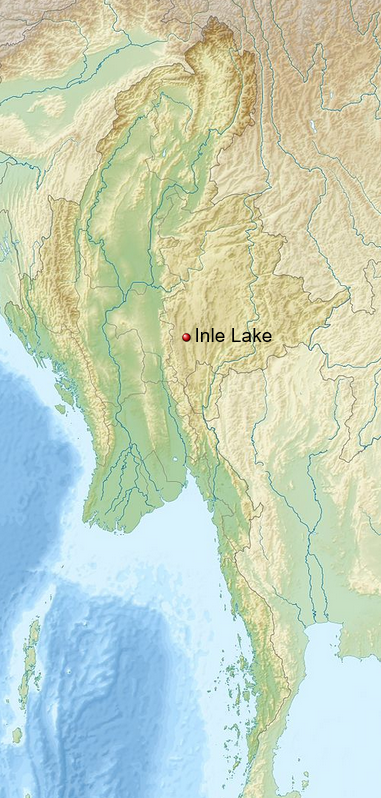 Inle Lake, in the province of Shan, became a UNESCO World Network Biosphere Reserve in 2015. It’s the second largest freshwater lake in Myanmar, lying at an altitude of 2,900 feet (880 meters), with a width of 7 miles (11 km), a length of 13.5 miles (22km), and an average depth of only 2.2 yards (2 meters). This large, shallow body of warm freshwater nurtures the growth of a variety of vegetation. In addition, it sustains 35 different species of fish, 17 of which are endemic (native to this area).
Inle Lake, in the province of Shan, became a UNESCO World Network Biosphere Reserve in 2015. It’s the second largest freshwater lake in Myanmar, lying at an altitude of 2,900 feet (880 meters), with a width of 7 miles (11 km), a length of 13.5 miles (22km), and an average depth of only 2.2 yards (2 meters). This large, shallow body of warm freshwater nurtures the growth of a variety of vegetation. In addition, it sustains 35 different species of fish, 17 of which are endemic (native to this area).
We had traveled to Inle Lake by bus, 400 miles (645 km) from Yangon due north. Although it was meant to be a direct bus, it was slow and often stopped en route to pick up and drop off passengers, and for toilet breaks, food and drink.
By some extraordinary premonition, our next guesthouse had reserved a room for us which had two bathrooms. As we had both been hit by digestive issues, we spent the night in our respective bathrooms emptying the digestive tract from both ends, often simultaneously. The next day, still feeling fragile, we assessed ourselves and declared we had enough bowel control to embark on a boat trip on the lake. We did not regret it!
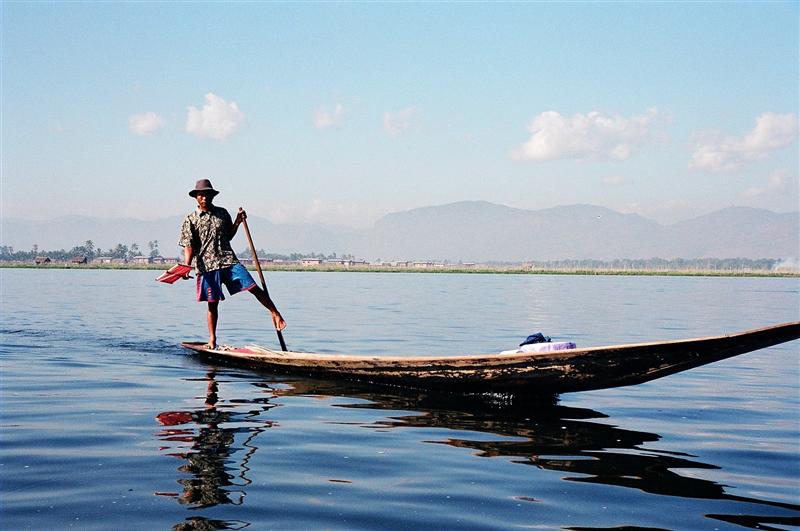
Fishing is one of the many commercial activities on this unique lake. The benefit of having both hands to work with has given rise to this interesting method of rowing.
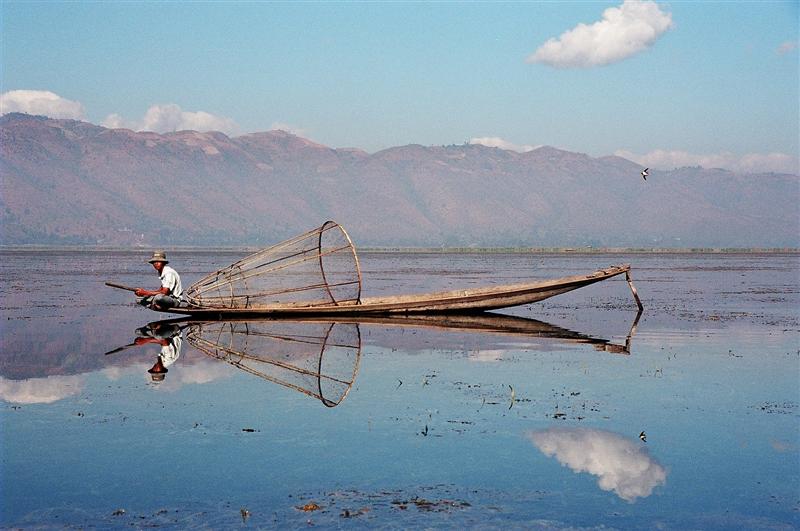
Others use a more conventional approach.
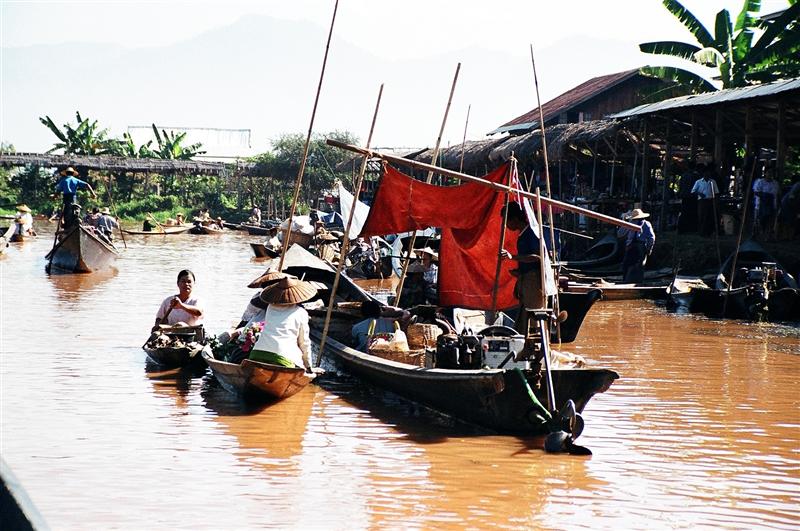
Small boats are a means of transport but also serve as small waterborne trading posts.
People live along the coast but also in floating villages where the houses are built on stilts. We went into one of these villages to see the arts and crafts: weaving, pottery and silk production. There are approximately seventeen villages on Inle Lake. The small boats allow for easy access between them.
I was fascinated by the floating gardens. Our boatman allowed me to step onto one. I just had to see if it would dip under my weight. Of course it did, but not enough to put my foot under water, just enough to let me know it was floating.
The climate favors the cultivation of rice, soy, tomatoes, cabbage, melons, papayas, and bananas. (Banana trees are visible in the second photo.) The gardens are anchored to the bottom of the lake with bamboo poles and the base (I have read) is clustered hyacinth roots that have a predilection for retaining soil and swampy debris. (Now this is a practical, positive use of the ability water hyacinths have. Mostly they are a nuisance as they tend to block waterways.)
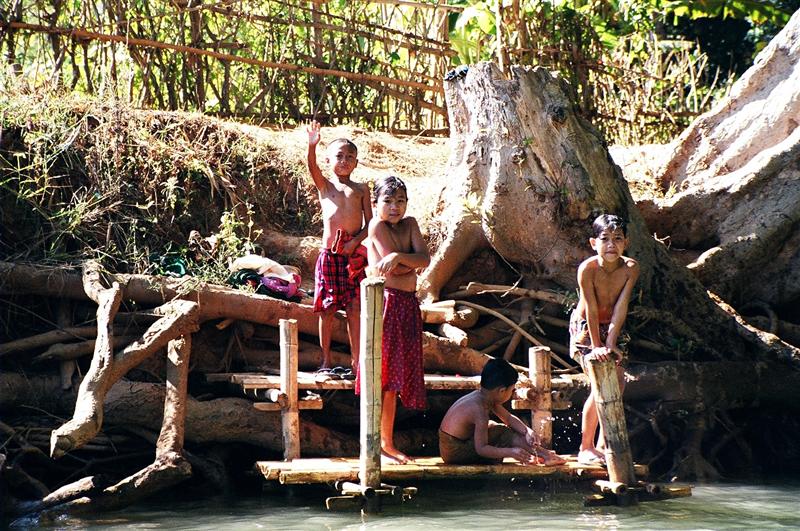
Children play in the water and wave at us, as we head back to our guesthouse (and our bathrooms).
Here water, sky, and land fully intermingle, and people move so gracefully within the setting.
Bagan (formerly Pagan)
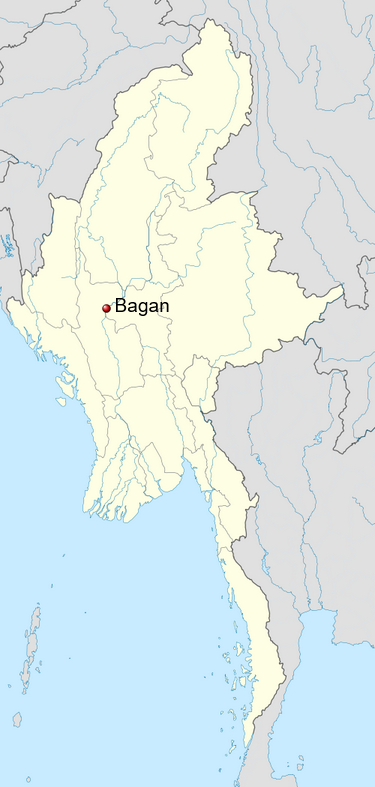 We covered the distance of 215 miles (346 km) from Inle Lake to Bagan by bus and train.
We covered the distance of 215 miles (346 km) from Inle Lake to Bagan by bus and train.
It seemed like a haphazard undertaking, to wait in a remote place with the promise of a bus coming soon!
And soon seemed a very elastic concept…
It was then a good sign when local people started joining us; that assured the likelihood of a bus’s arrival.
The train system at that time was still a relic from the British.
En route some photos of the paths we crossed:
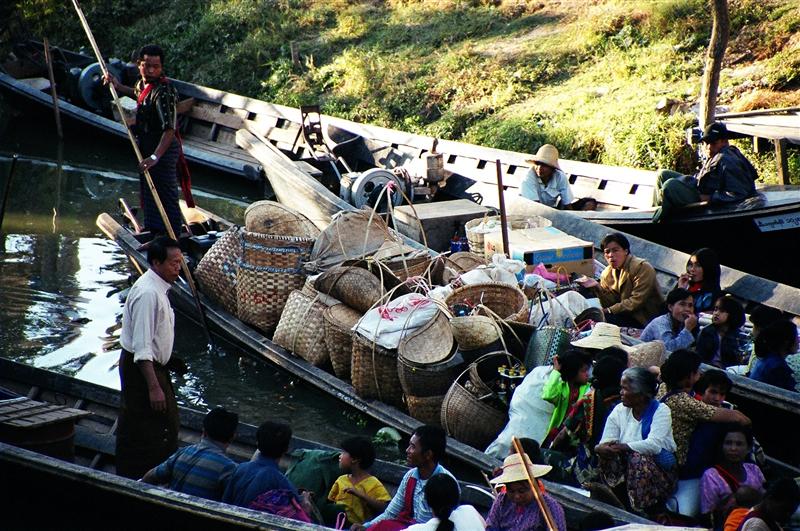
Walking from the bus station to the train station, this remarkable scene of boats laden with people and goods going to or from the market could not be ignored.
Left: Some cigars are bigger than others and that goes for ashtrays too.
Right: At the railway station. It gets chilly in the early morning as you head north.
Left: On the train. Such a wonderful, crowded jumble of people and goods.
Right: Men and women use a pale, colored paste made from finely-ground bark, called thanaka, on their faces for several reasons: for cosmetic purposes, its cooling properties, and as protection from the sun. It was early hours on the train, and people, mainly the girls, were still preparing themselves for the day.
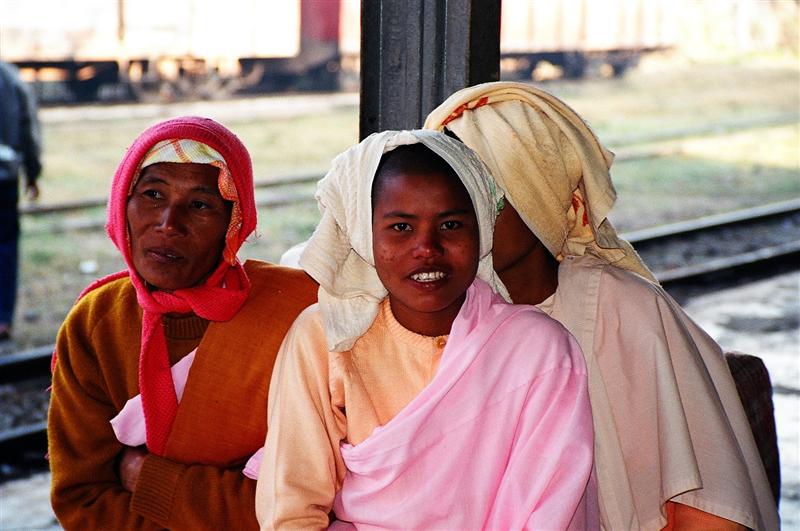
All wrapped up, waiting for the train.
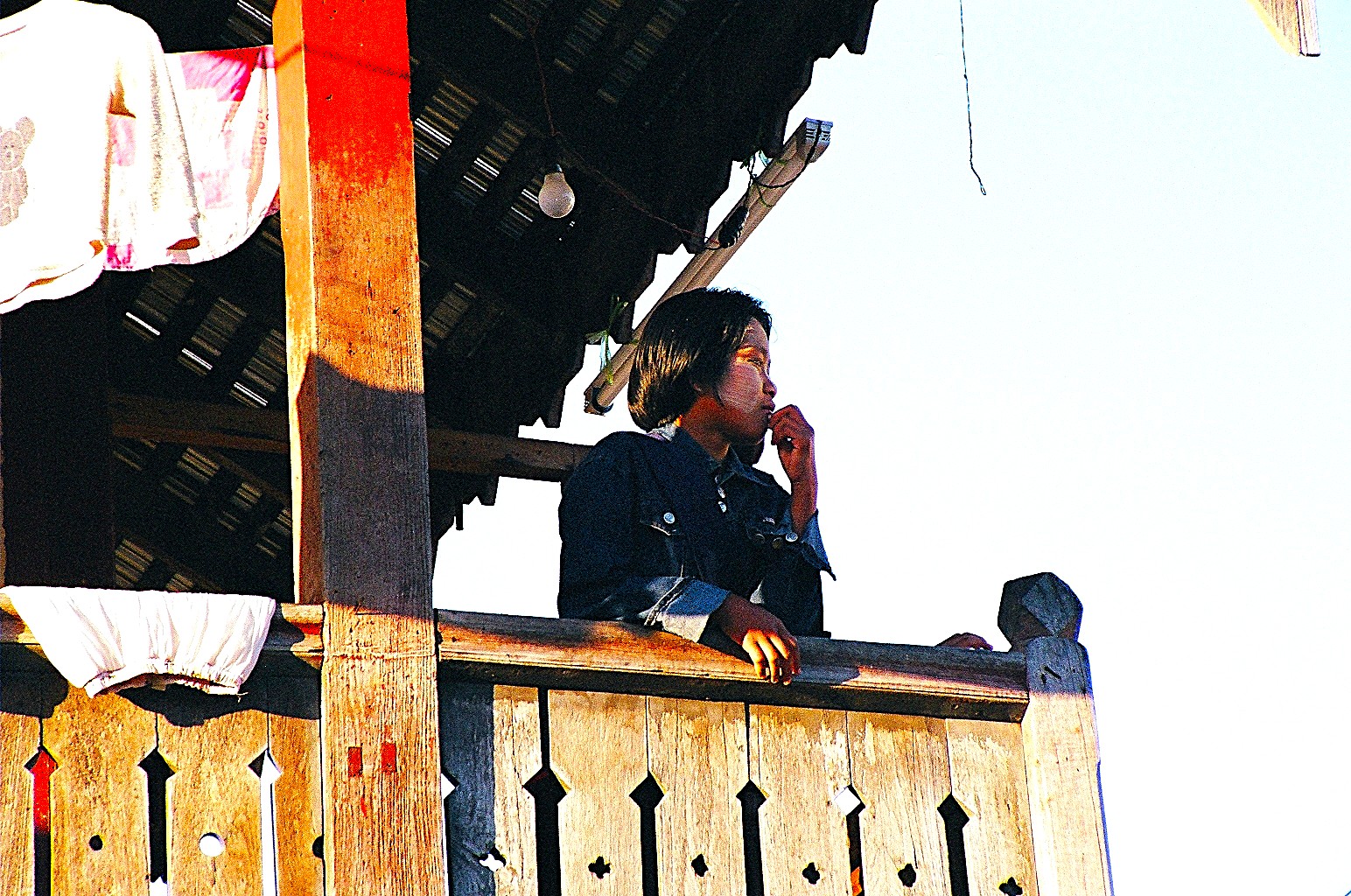
One wonders whether she is looking inward or outward. Note the paste on the cheeks.
The first Burmese kingdom was established in 849 CE and lasted until 1287 CE. And Bagan was its capital. It was from the land accumulations of this kingdom that modern-day Myanmar took its shape. The Burmese language and culture date from this time as does the spread of Theravada Buddhism. Thousands of temples were built, including the 10,000 temples, stupas, and monasteries in the Bagan region.
Bagan sits on the east bank of the Irrawaddy River, some 90 miles (145 km) southwest of Mandalay, which we also wanted to visit, but unfortunately we did not have the time. Purushottama would have loved to see it as he was there in 1976.
Note: The name Mandalay might be familiar to many because it was at the centre of the devastating earthquake that occurred on 28th March of this year. Because of its political opposition to the governing junta it did not receive the support needed to recover from the disaster. It is difficult to find any current news but as of the end of May many people were still sleeping outside under tarpaulins, enduring the intense heat of the day with no other shelter, and with limited food and water. Bagan was also affected and sustained damage to its ancient temples.
Statues of Buddha, in different temples. The stillness they engender is timeless. (Often a torch was needed to see them.)
As well as this being an ancient sacred site, the fields are tilled, and life is very present.
The murals are so ancient, the paint has faded, but the grace of the dancers, the sweetness of the facial expressions, something of the intent behind the creation continues to reverberate.
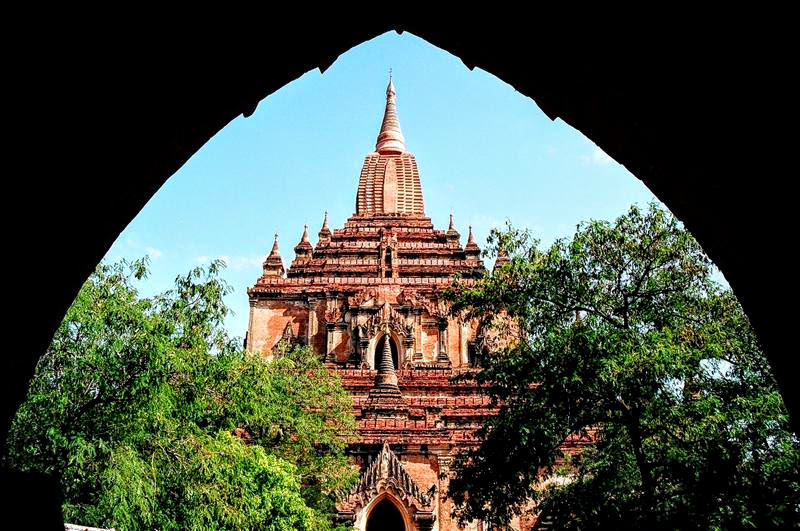
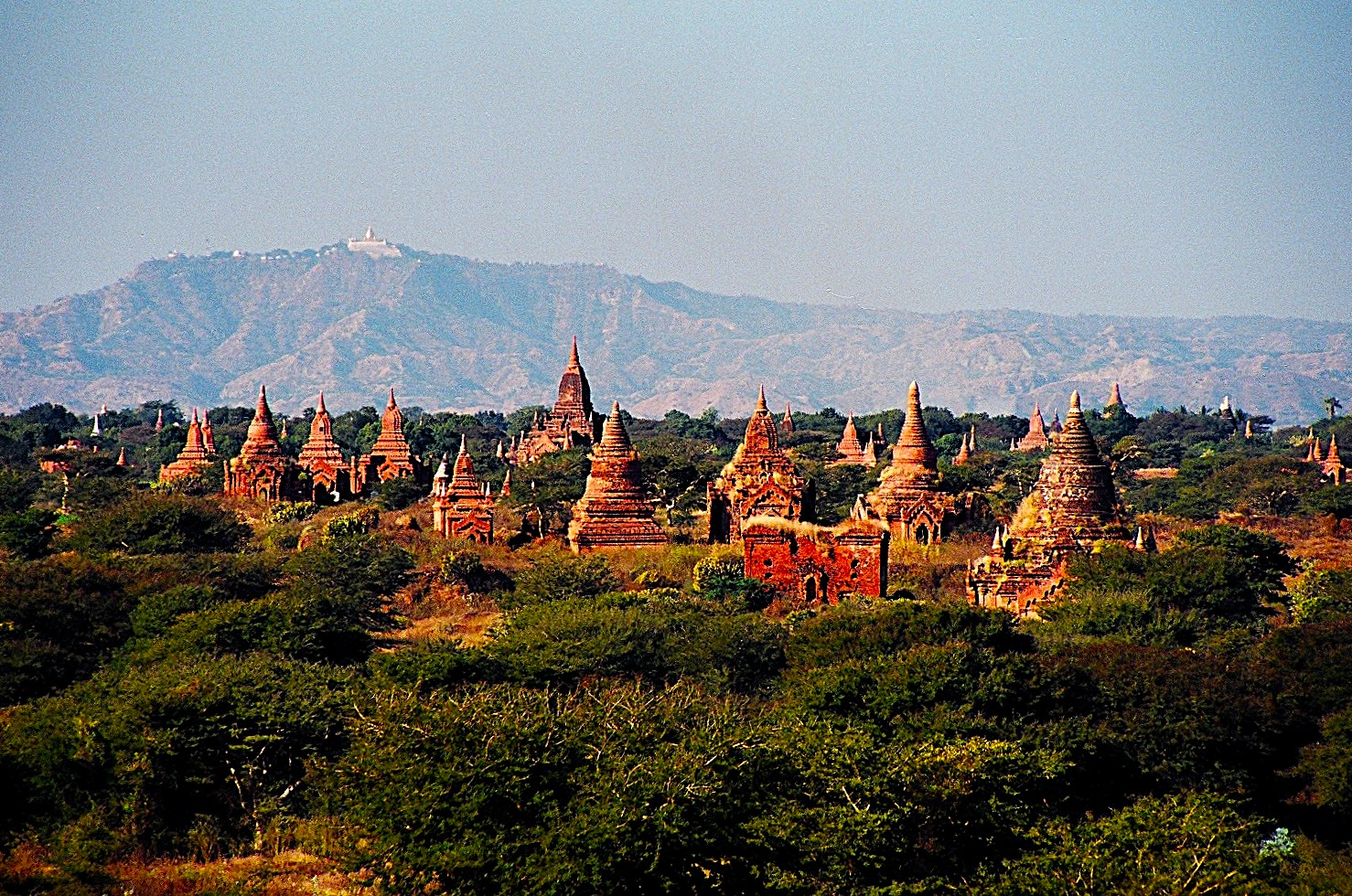
In some temples we were allowed to climb up to the roof to record the stunning wave upon wave of temples spreading across the valley as far as the hills beyond.
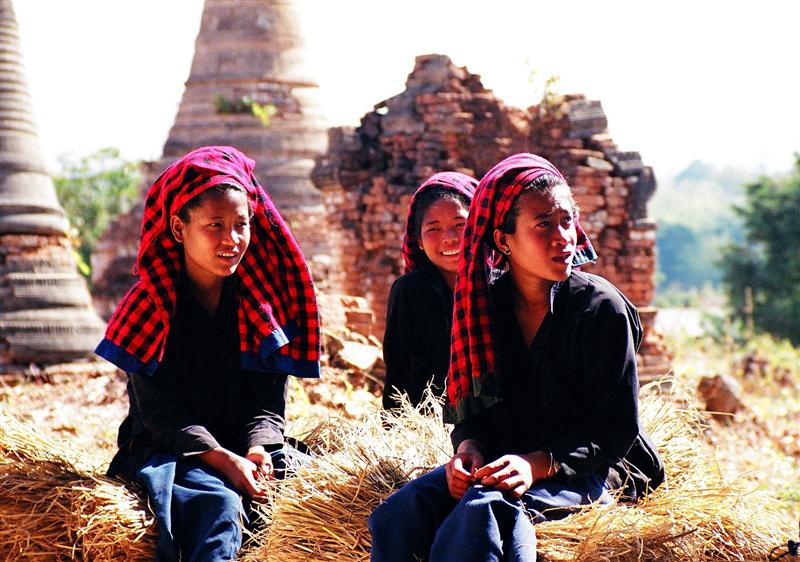
And here, the inheritors of this beauty live, work, and breathe.

Farewell Bagan.
Bagan was given the status of a UNESCO World Heritage Site in 2019, which gives hope that this irreplaceable place will receive the love and attention it deserves.
“May all beings be free from suffering and the cause of suffering.” 4
Sources
- wikipedia.org/Yangon
- worldpopulationreview.com
- wikipedia.org/Shwedagon_Pagoda – Shwedagon Pagoda on Singuttara Hill is on UNESCO’s Tentative List: whc.unesco.org
- From the Tibetan Four Immeasurables
Related article
- More from Amido and Purushottama’s travels on Osho News
Note: The photos for this article were converted from film to digital.



































Comments are closed.